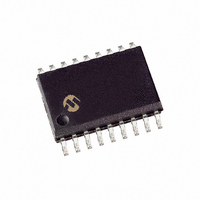MCP2510-I/SO Microchip Technology, MCP2510-I/SO Datasheet - Page 37

MCP2510-I/SO
Manufacturer Part Number
MCP2510-I/SO
Description
IC CAN CONTRLER IND TEMP 18SOIC
Manufacturer
Microchip Technology
Specifications of MCP2510-I/SO
Package / Case
18-SOIC (7.5mm Width)
Controller Type
CAN Interface
Interface
SPI
Voltage - Supply
3 V ~ 5.5 V
Current - Supply
10mA
Operating Temperature
-40°C ~ 85°C
Mounting Type
Surface Mount
Product
Controller Area Network (CAN)
Number Of Transceivers
1
Data Rate
5 Mbps
Supply Voltage (max)
5.5 V
Supply Voltage (min)
3 V
Supply Current (max)
10 mA
Maximum Operating Temperature
+ 85 C
Minimum Operating Temperature
- 40 C
Mounting Style
SMD/SMT
Lead Free Status / RoHS Status
Lead free / RoHS Compliant
For Use With
DV251001 - KIT DEVELOPMENT CAN MCP2510
Lead Free Status / Rohs Status
Lead free / RoHS Compliant
Available stocks
Company
Part Number
Manufacturer
Quantity
Price
Part Number:
MCP2510-I/SO
Manufacturer:
MICROCHIP/微芯
Quantity:
20 000
5.7
To compensate for phase shifts between the oscillator
frequencies of each of the nodes on the bus, each CAN
controller must be able to synchronize to the relevant
signal edge of the incoming signal. Synchronization is
the process by which the DPLL function is imple-
mented. When an edge in the transmitted data is
detected, the logic will compare the location of the edge
to the expected time (Sync Seg). The circuit will then
adjust the values of phase segment 1 and phase seg-
ment 2 as necessary. There are two mechanisms used
for synchronization.
5.7.1
Hard Synchronization is only done when there is a
recessive to dominant edge during a BUS IDLE condi-
tion, indicating the start of a message. After hard syn-
chronization, the bit time counters are restarted with
Sync Seg. Hard synchronization forces the edge which
has occurred to lie within the synchronization segment
of the restarted bit time. Due to the rules of synchroni-
zation, if a hard synchronization occurs there will not be
a resynchronization within that bit time.
5.7.2
As a result of Resynchronization, phase segment 1
may be lengthened or phase segment 2 may be short-
ened. The amount of lengthening or shortening of the
phase buffer segments has an upper bound given by
the Synchronization Jump Width (SJW). The value of
the SJW will be added to phase segment 1 (see
Figure 5-2) or subtracted from phase segment 2 (see
Figure 5-3). The SJW represents the loop filtering of
the DPLL. The SJW is programmable between 1 T
and 4 T
Clocking information will only be derived from reces-
sive to dominant transitions. The property that only a
fixed maximum number of successive bits have the
same value ensures resynchronization to the bit stream
during a frame.
FIGURE 5-2:
© 2007 Microchip Technology Inc.
T
Input Signal
Q
Q
Synchronization
.
HARD SYNCHRONIZATION
RESYNCHRONIZATION
Sync
LENGTHENING A BIT PERIOD
Segment
Prop
Segment 1
Phase
Q
≤ SJW
The phase error of an edge is given by the position of
the edge relative to Sync Seg, measured in T
phase error is defined in magnitude of T
• e = 0 if the edge lies within SYNCESEG
• e > 0 if the edge lies before the SAMPLE POINT
• e < 0 if the edge lies after the SAMPLE POINT of
If the magnitude of the phase error is less than or equal
to the programmed value of the synchronization jump
width, the effect of a resynchronization is the same as
that of a hard synchronization.
If the magnitude of the phase error is larger than the
synchronization jump width, and if the phase error is
positive, then phase segment 1 is lengthened by an
amount equal to the synchronization jump width.
If the magnitude of the phase error is larger than the
resynchronization jump width, and if the phase error is
negative, then phase segment 2 is shortened by an
amount equal to the synchronization jump width.
5.7.3
• Only one synchronization within one bit time is
• An edge will be used for synchronization only if
• All other recessive to dominant edges fulfilling
the previous bit
allowed
the value detected at the previous sample point
(previously read bus value) differs from the bus
value immediately after the edge
rules 1 and 2 will be used for resynchronization
with the exception that a node transmitting a dom-
inant bit will not perform a resynchronization as a
result of a recessive to dominant edge with a pos-
itive phase error
Sample
Point
SYNCHRONIZATION RULES
Segment 2
Phase
Bit Length
Nominal
MCP2510
DS21291F-page 37
Actual Bit
Q
Length
as follows:
Q
. The

















